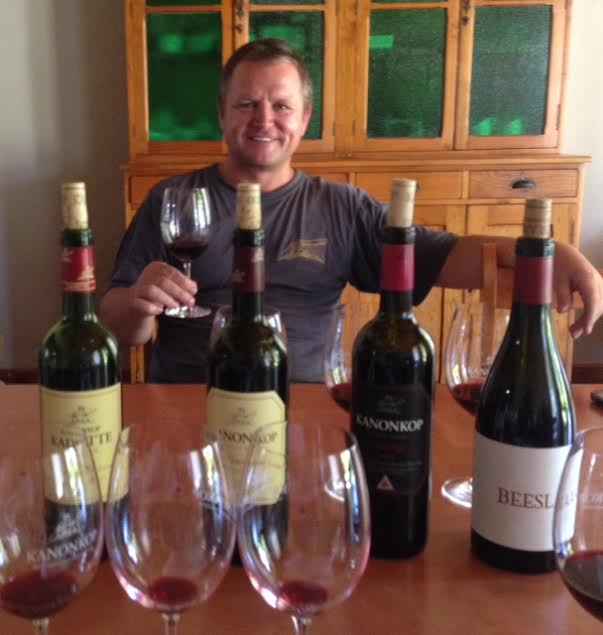Tim James: Abrie Beeslaar and his various takes on Pinotage
By Christian Eedes, 13 March 2017
Pinotage, so long the prisoner of its own conservative socio-cultural significance (as well as of inappropriate sites and winemaking), is starting to appear in more modern Cape guise – with fresh, exciting versions from Fram, David & Nadia, B Vintners and Spioenkop, for example.
But the grape has no more eloquent expression, I’d suggest, than in the wines of classically-oriented Abrie Beeslaar. Abrie stood on the shoulders of Beyers Truter at Kanonkop, and has more than ably guided that estate’s famous pinotage which for so long rose high above most of its competitors. He also brought into being the old-vineyard Black Label Pinotage, and has overseen the remarkable volume expansion of the Kadette version – something which continues apace. Not to mention introducing his own-label wine. Recently I’ve been researching and writing an article on pinotage, so a visit to Abrie to taste with him though his range was a necessity as well as a privilege and pleasure. He’s a thoroughly nice and modest man as well as a fine winemaker; all of this was obvious as I sat with him at his dining room table, in the house he lives in on the estate, scarcely more than a hundred metres from the scene of his daily labours.
Kadette is a label to make any Cape producer salivate with envy. The Cape Blend (at something like 140 000 six-bottle cases) is the volume leader, but the Pinotage is now at around 40 000 cases – and next year likely to be 10 000 more, at around R100 a bottle retail from your nearest supermarket, which ain’t nothing…. The 2015 is generously fruity – the sweetness is all ripe fruit, rather than sugar – appetising, with a decent structure of tannin and acid in easy balance. No great depth, perhaps, but pinotage is a grape that matures well and this would be a good investment for the medium-term future, I reckon, while being very approachable now.
The ageability of serious pinotage is recognised by Kanonkop, which each year releases a 10-year old vintage – this year the 2007, at under R500, a reasonable price given that maturity. I didn’t try it on this occasion, but I have no doubt that the current-release 2014 will be drinking well in a decade. It’s too young now, and it would be wasteful to broach it before at least five years. It’s much more intense and characterful than the Kadette, with a fresh brightness and firmer structure firmly controlling the pure, ripe and rich fruit, the oak integrated and supportive.
There’s some confusion, I feel, over the marketing of the old-vineyard (60+ years) Black Label. It’s somewhat bizarre that this expensive pinotage flagship (about R1600) is put on the market a year younger than the standard Kanonkop, though not now sold en primeur. I get the impression that Abrie would much rather let it develop a little before offering it. But here the 2015 is, and it promises something splendid to come. The all-new oak is still too obvious, stressing the cocoa note that is in the fruit. It’s a broad, luxurious wine, velvety and intense, with a richer, spicier vinosity than the standard version. “We’re past the point”, says Abrie, “where we’re trying to make good pinotage; we’re aiming to make good wine”. And succeeding.
I must say, however, that however grand and fine the Kanonkop Black Label, I think even more highly of the Beeslaar Pinotage 2015. Abrie’s been making this wine since the 2012 vintage – from a Stellenbosch vineyard which used to supply grapes for Kadette, with shale rather than Kanonkop’s granitic soils. It’s partly that in youth the lesser use of new oak barrels (just 50%) makes for earlier integration, but the focus is altogether more elegant and refined, without losing that luxurious gorgeousness – the comparative preponderance of red over black fruit helping here.
There’s a lovely pinot-like perfume to the wine and I mentioned to Abrie that the Beeslaar Pinotage could show well amongst a range of high quality burgundies of richer style. One think would mark it, however, I suggested (and I feel it a slight detraction from a wine that is certainly in the top rung of Cape reds), and that is the touch of sweetness on the finish. Abrie sighed a little wistfully, and admitted that he would love his wine to have a more savoury note to it, and a lower alcohol. I think he’ll get there.
- Tim James is founder of Grape.co.za and contributes to various local and international wine publications. He is a taster (and associate editor) for Platter’s. His book Wines of South Africa – Tradition and Revolution appeared in 2013.









Comments
0 comment(s)
Please read our Comments Policy here.